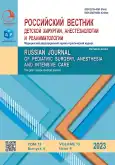生理盐水在新生儿外科手术中的有效性评估
- 作者: Nasser M.M.1, Zhirkova Y.V.1,2, Kucherov Y.I.1,2
-
隶属关系:
- Speransky Children’s Hospital No. 9
- Pirogov Russian National Research Medical University
- 期: 卷 13, 编号 4 (2023)
- 页面: 491-502
- 栏目: Original Study Articles
- URL: https://journals.rcsi.science/2219-4061/article/view/249859
- DOI: https://doi.org/10.17816/psaic1550
- ID: 249859
如何引用文章
全文:
详细
论证。近年来,新生儿外科手术不断发展和进步,其中包括对麻醉方法的深入研究,以及将所学知识引入医生-麻醉师-复苏师的日常工作中。考虑到新生儿期的解剖生理特点,对新生儿输液治疗方法进行深入研究是影响未来治疗效果的基本因素之一。
目的。本文旨在研究新生儿在手术过程中与基础输液环境选择有关的电解质平衡、酸碱指标和血流动力学指标。
材料和方法。我们对99名新生儿进行了前瞻性研究。在手术过程中,所有患儿都接受了生理盐水输注,输注量为10毫升/(千克-小时)。I组术中注射等渗的 苹果酸电解质静注液,II组注射0.9%氯化钠溶液,III组注射林格氏溶液。为11名儿童注射了0.45%低渗氯化钠溶液。对静脉血的酸碱状态和电解质成分、血流动力学参数以及围手术期肌力支持的需求进行了评估。
结果。在接受0.45%低渗氯化钠溶液治疗的患儿中出现了低钠血症的倾向,这也是拒绝进一步招募患儿加入该组和进行该变体研究的原因。手术干预后,三组患儿的pH值均保持代偿状态。同时,在所有组中,都记录到了碳酸氢盐和BE减少形式的代谢紊乱。所有组别都发现了电解质紊乱,其中电解质平衡在I组最为常见;离子图紊乱在II组和III组更为常见,表现为钾降低、钠升高、氯升高和钙升高。在对手术干预期间的血流动力学参数进行的研究中,在输注不同生理盐水介质的各组之间进行比较,没有发现明显的统计学差异。
结论。我们的研究结果表明,在新生儿术中使用不同的生理盐水作为基本输注疗法时,酸碱状态和血流动力学参数没有明显差异。在研究电解质平衡时,使用0.9%氯化钠溶液组最常见的并发症是低钾血症、高钠血症和高氯血症。
作者简介
Marianna M. Nasser
Speransky Children’s Hospital No. 9
编辑信件的主要联系方式.
Email: mnasser@bk.ru
ORCID iD: 0000-0002-9080-7419
SPIN 代码: 9157-0420
俄罗斯联邦, Moscow
Yulia V. Zhirkova
Speransky Children’s Hospital No. 9; Pirogov Russian National Research Medical University
Email: zhirkova@mail.ru
ORCID iD: 0000-0001-7861-6778
SPIN 代码: 5560-6679
MD, Dr. Med. (Sci.), Professor
俄罗斯联邦, Moscow; MoscowYurii I. Kucherov
Speransky Children’s Hospital No. 9; Pirogov Russian National Research Medical University
Email: ykucherov@mail.ru
ORCID iD: 0000-0001-7189-373X
SPIN 代码: 4391-4472
MD, Dr. Sci. (Med.), Professor
俄罗斯联邦, Moscow; Moscow参考
- Visram AR. Intraoperative fluid therapy in neonates. South Afr J AnaesthAnalg. 2016;22(2):46–51. doi: 10.1080/22201181.2016.1140705
- Shahidullah M, C Das J, Mannan M. Fluid and electrolyte management in newborn infant. J Bangladesh Perinat Soc. 2009;1(2):39–43.
- Ayus JC, Achinger SG, Arieff A. Brain cell volume regulation in hyponatremia: role of sex, age, vasopressin, and hypoxia. Am J Physiol Renal Physiol. 2008;295(3):619–624. doi: 10.1152/ajprenal.00502.2007
- Craig J, Cunliffe M, Gildersleve C, et al. APA Consensus guideline on perioperative fluid management in children v. 1.1September 2007 © APAGBI Review Date August 2010 [cited 2023 Oct 11]. Available at: https://www.apagbi.org.uk/sites/default/files/inline-files/Perioperative_ Fluid_Management_2007.pdf
- HamidrezaSh, Khavarian N, Amir K, Mohamadreza H. Comparison the effects of using two methods of fluid therapy with normal saline or 5% dextrose in half amount of normal saline solution on blood glucose and plasma. J Clin Neonatol. 2022;11(2):79–85. doi: 10.4103/jcn.jcn_131_21
- Nasser M, Zhirkova Yu, Matveev S. Analysis of the postoperative period in newborns depending on the composition of intraoperative infusion. Znanstvena Misel. 2021;(59):12–16.
- Nasser MM, Kucherov YuI, Zhirkova YuV. Comparative analysis of using balanced and normal saline solutions as an intraoperative therapy in newborns. Russian Journal of Pediatric Surgery, Anesthesia and Intensive Care. 2019;9(2):41–49. doi: 10.30946/2219-4061-2019-9-2-41-49
- Mertzlufft F, Brettner F, Crystal GJ, et al. Intravenous fluids: issues warranting concern. Eur J Anaesthesiol. 2022;39(4):394–396. doi: 10.1097/EJA.0000000000001568
- Sümpelmann R, Becke K, Crean P, et al.European consensus statement for intraoperative fluid therapy in children. Eur J Anaesthesiol. 2011;28(9):637–639. doi: 10.1097/EJA.0b013e3283446bb8
- Vignarajah M, Berg A, Abdallah Z, et al. Intraoperative use of balanced crystalloids versus 0.9% saline: a systematic review and meta-analysis of randomised controlled studies. Br J Anaesth. 2023;131(3):463–471. doi: 10.1016/j.bja.2023.05.029
- Eaddy N, Watene C. Perioperative management of fluids and electrolytes in children. BJA Educ. 2023;23(7):273–278. doi: 10.1016/j.bjae.2023.03.006
- Varadhan KK, Lobo DN.A meta-analysis of randomised controlled trials of intravenous fluid therapy in major elective open abdominal surgery: getting the balance right. Proc Nutr Soc. 2010;69(4):488–498. doi: 10.1017/S0029665110001734
- O’Brien F, Walker IA. Fluid homeostasis in the neonate. Paediatr Anaesth. 2014;24(1):49–59. doi: 10.1111/pan.12326
- EdjoNkilly G, Michelet D, Hilly J, et al. Postoperative decrease in plasma sodium concentration after infusion of hypotonic intravenous solutions in neonatal surgery. Br J Anaesth. 2014;112(3):540–545. doi: 10.1093/bja/aet374
- Lönnqvist P-A. Fluid management in association with neonatal surgery: even tiny guys need their salt. Br J Anaesth. 2014;112(3):404–406. doi: 10.1093/bja/aet436
- Wagener G, Bezinover D, Wang C, et al. Fluid management during kidney transplantation: a consensus statement of the committee on transplant anesthesia of the American society of anesthesiologists. Transplantation. 2021;105(8):1677–1684. doi: 10.1097/TP.0000000000003581
- Pfortmueller C, Funk GC, Potura E, et al.Acetate-buffered crystalloid infusate versus infusion of 0.9% saline and hemodynamic stability in patients undergoing renal transplantation: Prospective, randomized, controlled trial. Wien Klin Wochenschr. 2017;129(17-18):598–604. doi: 10.1007/s00508-017-1180-4
- Arslantas R, Dogu Z, Cevik BE. Normal saline versus balanced crystalloid solutions for kidney transplantation. Transplant Proc. 2019;51(7):2262–2264. doi: 10.1016/j.transproceed.2019.03.050
- Potura E, Lindner G, Biesenbach P, et al. An acetate-buffered balanced crystalloid versus 0.9% saline in patients with end-stage renal disease undergoing cadaveric renal transplantation: a prospective randomized controlled trial. Anesth Analg. 2015;120(1):123–129. doi: 10.1213/ANE.0000000000000419
- Arumainathan R, Stendall C, Visram A. Management of fluids in neonatal surgery. BJA Educ. 2018;18(7):199–203. doi: 10.1016/j.bjae.2018.03.006
补充文件










